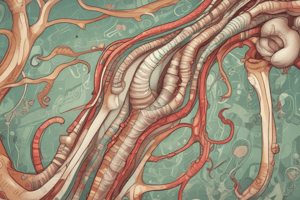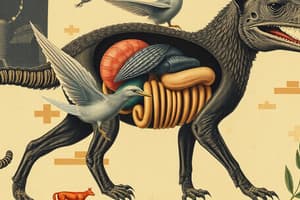Podcast
Questions and Answers
Which type of digestive system is found in birds?
Which type of digestive system is found in birds?
- Ruminant
- Avian (correct)
- Polygastric
- Monogastric
What is the primary function of the omasum in a cow's digestive system?
What is the primary function of the omasum in a cow's digestive system?
- Production of volatile fatty acids
- Absorption of water and nutrients (correct)
- Synthesis of amino acids and vitamins
- Breakdown of cellulose in plant cell walls
What is the primary role of microbes in a cow's rumen?
What is the primary role of microbes in a cow's rumen?
- Breaking down proteins into amino acids
- Breaking down cellulose in plant cell walls (correct)
- Synthesizing vitamins and minerals
- Absorbing volatile fatty acids
What is the final stage of the digestive process in animals?
What is the final stage of the digestive process in animals?
What is the name of the fourth chamber in a cow's digestive system?
What is the name of the fourth chamber in a cow's digestive system?
Which type of digestive system is characterized by a single-chambered stomach?
Which type of digestive system is characterized by a single-chambered stomach?
What is the byproduct of microbial fermentation in a cow's rumen?
What is the byproduct of microbial fermentation in a cow's rumen?
What is the primary mechanism of nutrient absorption in the small intestine?
What is the primary mechanism of nutrient absorption in the small intestine?
Which type of digestive system is characterized by a multi-chambered stomach?
Which type of digestive system is characterized by a multi-chambered stomach?
What is the main function of the large intestine?
What is the main function of the large intestine?
What is the role of bile acids in the small intestine?
What is the role of bile acids in the small intestine?
Which of the following is NOT a type of digestive enzyme found in pancreatic juice?
Which of the following is NOT a type of digestive enzyme found in pancreatic juice?
What is the first stage of the digestive process in humans?
What is the first stage of the digestive process in humans?
Which of the following is a function of the small intestine?
Which of the following is a function of the small intestine?
What is the primary function of the stomach in the digestive process?
What is the primary function of the stomach in the digestive process?
Which of the following is NOT a main bile acid produced in the liver?
Which of the following is NOT a main bile acid produced in the liver?
What is the final destination of absorbed nutrients in the digestive process?
What is the final destination of absorbed nutrients in the digestive process?
Flashcards are hidden until you start studying
Study Notes
Digestive Systems
- Different types of digestive systems found in animals:
- Monogastric: one-chambered stomach (e.g. humans, dogs, cats)
- Polygastric: multi-chambered stomach (e.g. cows, sheep, goats)
- Avian: specialized digestive system with crop and gizzard (e.g. birds)
- Functions of the digestive system:
- Ingestion: taking in food
- Digestion: breaking down food into smaller molecules
- Absorption: absorbing nutrients into the bloodstream
- Elimination: removing waste products
Digestion in Cows
- Ruminant digestive system: cows have a four-chambered stomach
- Rumen: first chamber, where food first enters and is broken down by microbes
- Reticulum: second chamber, where food is further broken down
- Omasum: third chamber, where water and nutrients are absorbed
- Abomasum: fourth chamber, similar to the human stomach
- Digestive process in cows:
- Food enters the rumen, where microbes break down cellulose in plant cell walls
- Volatile fatty acids (VFAs) are produced as a byproduct of microbial fermentation
- VFAs are absorbed and used as energy by the cow
- microbes in the rumen also synthesize amino acids and vitamins
- Food then passes through the remaining chambers, where further digestion and absorption occur
Digestive Systems
- Digestive systems in animals vary, with three main types:
- Monogastric: one-chambered stomach, found in humans, dogs, and cats
- Polygastric: multi-chambered stomach, found in cows, sheep, and goats
- Avian: specialized digestive system with crop and gizzard, found in birds
- Key functions of the digestive system include:
- Ingestion: taking in food through the mouth
- Digestion: breaking down food into smaller molecules through mechanical and chemical means
- Absorption: absorbing nutrients into the bloodstream for use by the body
- Elimination: removing waste products from the body
Ruminant Digestive System in Cows
- Cows have a four-chambered stomach, known as the ruminant digestive system:
- Rumen: first chamber, where food first enters and is broken down by microbes
- Reticulum: second chamber, where food is further broken down
- Omasum: third chamber, where water and nutrients are absorbed
- Abomasum: fourth chamber, similar to the human stomach
- The digestive process in cows involves:
- Microbial fermentation in the rumen, where microbes break down cellulose in plant cell walls
- Production of volatile fatty acids (VFAs) as a byproduct of microbial fermentation
- Absorption of VFAs, which are used as energy by the cow
- Synthesis of amino acids and vitamins by microbes in the rumen
- Further digestion and absorption in the remaining chambers
Nutrient Absorption
- Nutrient absorption occurs in the small intestine through diffusion, active transport, and facilitated diffusion.
- Diffusion involves the movement of nutrients from an area of high concentration to an area of low concentration.
- Active transport involves the movement of nutrients against their concentration gradient using energy.
- Facilitated diffusion involves the movement of nutrients through transport proteins in the cell membrane.
Digestive Systems
- There are three types of digestive systems: monogastric, polygastric, and avian.
- Monogastric digestive systems have a one-chambered stomach and are found in humans, pigs, and horses.
- Polygastric digestive systems have a multi-chambered stomach and are found in ruminants such as cows and sheep.
- Avian digestive systems are specialized and found in birds.
- The digestive system performs three main functions: mechanical breakdown, chemical breakdown, and absorption of nutrients.
Digestion in Humans
- The digestive process in humans involves five stages: ingestion, swallowing, gastric digestion, small intestine, and large intestine.
- Ingestion involves food entering the mouth where it is chewed and mixed with saliva.
- Swallowing involves food being swallowed and passing through the esophagus into the stomach.
- Gastric digestion involves food being mixed with stomach acid and digestive enzymes in the stomach.
- The small intestine is where nutrients are absorbed into the bloodstream.
- The large intestine is where water and electrolytes are absorbed, and waste is eliminated.
Acids Used in Small Intestine
- Bile acids are produced in the liver and stored in the gallbladder.
- Bile acids are released into the small intestine to emulsify fats and facilitate fat absorption.
- The main bile acids are cholic acid, chenodeoxycholic acid, and deoxycholic acid.
- Pancreatic juice is produced in the pancreas and released into the small intestine.
- Pancreatic juice contains digestive enzymes such as amylase, lipase, and trypsin.
- The pH of pancreatic juice is alkaline, helping to neutralize acidic chyme from the stomach.
Stomach
- The stomach performs three main functions: mechanical breakdown, chemical breakdown, and secretion of mucus.
- Mechanical breakdown involves the muscular contractions of the stomach.
- Chemical breakdown involves the release of gastric enzymes that break down proteins.
- The stomach secretes mucus to protect the stomach lining from acid and enzymes.
- Gastric acid is produced by parietal cells in the stomach lining.
- The pH of gastric acid is acidic, ranging from 1.5 to 3.5.
- Gastric acid helps to denature proteins and activate digestive enzymes.
Studying That Suits You
Use AI to generate personalized quizzes and flashcards to suit your learning preferences.




